清华大学跨文化课程教案7精品教育文档
跨文化交流优秀教案的跨文化教学设计
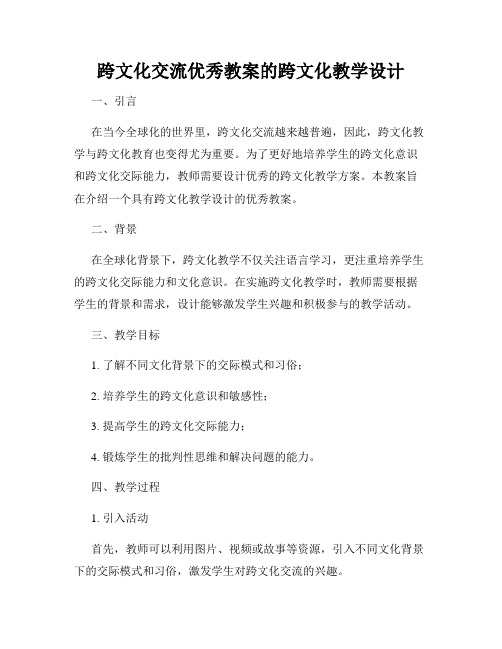
跨文化交流优秀教案的跨文化教学设计一、引言在当今全球化的世界里,跨文化交流越来越普遍,因此,跨文化教学与跨文化教育也变得尤为重要。
为了更好地培养学生的跨文化意识和跨文化交际能力,教师需要设计优秀的跨文化教学方案。
本教案旨在介绍一个具有跨文化教学设计的优秀教案。
二、背景在全球化背景下,跨文化教学不仅关注语言学习,更注重培养学生的跨文化交际能力和文化意识。
在实施跨文化教学时,教师需要根据学生的背景和需求,设计能够激发学生兴趣和积极参与的教学活动。
三、教学目标1. 了解不同文化背景下的交际模式和习俗;2. 培养学生的跨文化意识和敏感性;3. 提高学生的跨文化交际能力;4. 锻炼学生的批判性思维和解决问题的能力。
四、教学过程1. 引入活动首先,教师可以利用图片、视频或故事等资源,引入不同文化背景下的交际模式和习俗,激发学生对跨文化交流的兴趣。
2. 学习不同文化背景下的交际模式和习俗通过小组合作和讨论,学生们可以分享自己的文化背景,并了解其他同学的文化。
同时,教师可以通过案例分析和问题引导,帮助学生理解不同文化间的交际模式和习俗。
3. 进行跨文化交际活动教师可以设计一系列跨文化交际活动,如角色扮演、文化展览、文化对比等。
通过这些活动,学生们可以亲身体验跨文化交际的挑战和乐趣,提高他们的跨文化交际能力。
4. 分析和解决跨文化交际中的问题教师与学生一起分析和解决跨文化交际中的问题,培养学生的批判性思维和解决问题的能力。
教师可以提供真实案例,引导学生思考并提出解决方案,同时鼓励学生团队合作和创新思维。
五、评估方式教师可以采用多种评估方式,包括个人报告、小组项目展示、文化交际能力测试等。
评估的重点应该是学生对不同文化背景下交际模式和习俗的理解和应用能力。
六、教学资源与参考书目教师可以准备一些跨文化交际的教学资源,如图片、视频、故事和文化背景介绍等。
此外,教师还可以参考相关的跨文化教育理论与研究作品,以提高教学的质量和效果。
培养跨文化交流能力教案

培养跨文化交流能力教案教案:培养跨文化交流能力教案一、教学目标通过本课的学习,学生应能够:1. 了解跨文化交流的重要性;2. 掌握跨文化交流的基本技巧;3. 增强自己的跨文化适应能力;4. 培养尊重和理解不同文化的意识。
二、教学重点1. 跨文化交流的基本概念;2. 跨文化交流的必备技巧;3. 跨文化适应能力的培养。
三、教学准备1. PowerPoint演示稿;2. 学生手册和笔记。
四、教学过程Step 1 引入1. 向学生介绍跨文化交流的概念,并讨论它为什么重要。
2. 引导学生思考跨文化交流可能遇到的问题,并提出解决之道。
Step 2 跨文化交流的基本概念1. 通过PowerPoint演示,向学生介绍跨文化交流的基本概念,包括不同文化之间的差异、合作和交流的重要性等。
2. 提供一些真实的案例,让学生感受到跨文化交流的实际问题和挑战。
Step 3 跨文化交流的基本技巧1. 向学生介绍跨文化交流的基本技巧,包括尊重、注意非语言交流、适应不同的沟通风格等。
2. 引导学生讨论并总结出适应跨文化交流的具体技巧和策略。
Step 4 跨文化适应能力的培养1. 向学生介绍跨文化适应能力的重要性,并讨论如何培养这种能力。
2. 分组讨论,让学生分享自己在跨文化环境中的经验和感悟,并相互交流建议和解决问题的方法。
Step 5 案例分析与综合实践1. 提供一些跨文化交流案例,让学生分析并提出解决方案。
2. 分组演练跨文化交流场景,模拟实际情境,让学生应用所学技巧进行跨文化交流实践。
Step 6 总结与评价1. 对本节课所学内容进行总结,并与学生一起回顾重点。
2. 展示学生在跨文化交流实践中的表现,鼓励他们勇敢尝试并提出改进意见。
五、作业布置要求学生以跨文化交流为主题,撰写一篇500字的体验文章。
文章内容可以包括在实践中遇到的挑战、解决问题的方法以及感悟体会等。
六、课后反思通过对学生的观察和表现,评价本节课的教学效果,并思考如何进一步提升学生的跨文化交流能力。
跨文化交流国际文化交流项目教案
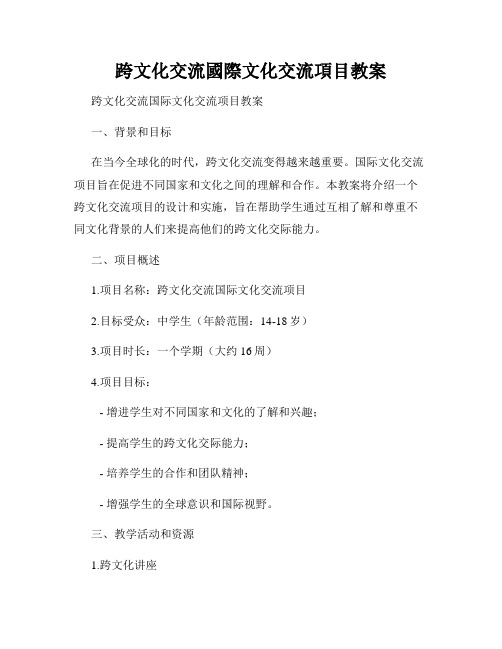
跨文化交流國際文化交流項目教案跨文化交流国际文化交流项目教案一、背景和目标在当今全球化的时代,跨文化交流变得越来越重要。
国际文化交流项目旨在促进不同国家和文化之间的理解和合作。
本教案将介绍一个跨文化交流项目的设计和实施,旨在帮助学生通过互相了解和尊重不同文化背景的人们来提高他们的跨文化交际能力。
二、项目概述1.项目名称:跨文化交流国际文化交流项目2.目标受众:中学生(年龄范围:14-18岁)3.项目时长:一个学期(大约16周)4.项目目标:- 增进学生对不同国家和文化的了解和兴趣;- 提高学生的跨文化交际能力;- 培养学生的合作和团队精神;- 增强学生的全球意识和国际视野。
三、教学活动和资源1.跨文化讲座- 邀请来自不同国家的嘉宾进行讲座,介绍他们的国家和文化。
- 学生可以提前准备问题,并互动交流。
- 要求学生记录笔记,并分享他们学到的新知识。
2.文化展示- 鼓励学生以小组形式选择一个国家,并展示该国家的文化特色。
- 学生可以运用多种形式,如图片、音乐、艺术品等展示。
- 学生之间可以进行问答和互动。
3.文化对比- 学生分成小组,选择两个不同国家进行文化对比研究。
- 对比的内容可以包括风俗习惯、宗教信仰、教育制度等。
- 学生撰写对比论文,并进行展示。
4.虚拟交流- 与外国学生或学生组织建立网络联系,进行虚拟交流活动。
- 学生可以通过电子邮件、视频会议等方式交流。
- 学生可以互相介绍家乡文化、学校生活等。
5.实地考察- 组织学生参观当地的国际组织、外国驻华使馆等。
- 学生可以近距离接触其他国家的代表和文化。
- 学生要进行观察和记录,并在之后进行分享。
四、评估方法1.小组展示评估- 对每个小组的文化展示进行评估,包括内容、表达能力和团队合作。
- 每个小组的成员需要轮流发言和回答问题。
2.个人反思- 要求学生在项目结束后撰写一篇个人反思报告。
- 学生可以谈论在项目中收获和遇到的挑战,以及如何改进跨文化交际能力。
《跨文化沟通》参考教案
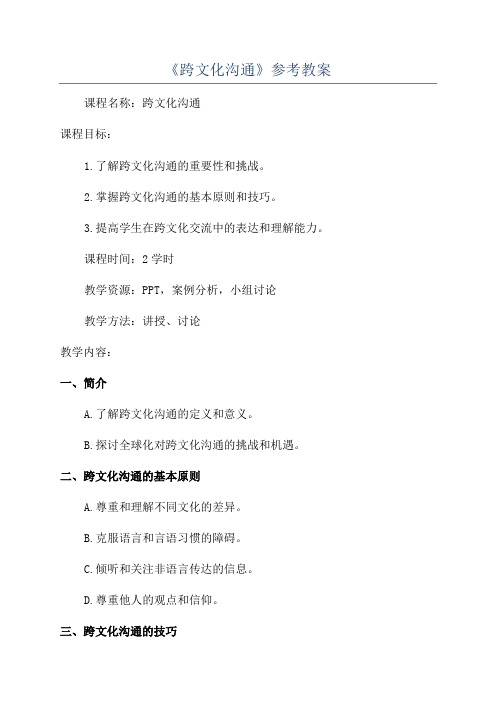
《跨文化沟通》参考教案课程名称:跨文化沟通课程目标:1.了解跨文化沟通的重要性和挑战。
2.掌握跨文化沟通的基本原则和技巧。
3.提高学生在跨文化交流中的表达和理解能力。
课程时间:2学时教学资源:PPT,案例分析,小组讨论教学方法:讲授、讨论教学内容:一、简介A.了解跨文化沟通的定义和意义。
B.探讨全球化对跨文化沟通的挑战和机遇。
二、跨文化沟通的基本原则A.尊重和理解不同文化的差异。
B.克服语言和言语习惯的障碍。
C.倾听和关注非语言传达的信息。
D.尊重他人的观点和信仰。
三、跨文化沟通的技巧A.适应不同的沟通风格和方式。
B.学会引导和澄清沟通含义。
C.掌握合适的肢体语言和面部表情。
D.了解不同文化的礼仪和习俗。
四、案例分析A.分析跨文化交流中可能出现的问题和误解。
B.讨论如何解决跨文化沟通中的难题。
五、小组讨论A.组织学生进行小组讨论,讨论跨文化沟通的体验和感悟。
B.学生分享在跨文化交流中的成功和失败经历。
教学步骤:一、引入介绍跨文化沟通的定义和意义,让学生了解为什么需要学习跨文化沟通的技巧。
二、讲授讲解跨文化沟通的基本原则和技巧,帮助学生建立正确的跨文化交流观念。
三、案例分析通过分析实际案例,让学生了解跨文化沟通中可能出现的问题和挑战,并讨论如何解决这些问题。
四、小组讨论组织学生进行小组讨论,分享跨文化交流的体验和感悟,学生可以分享自己的成功和失败经历,互相学习和借鉴。
五、总结总结课程内容,强调跨文化沟通的重要性和实践中需要注意的事项。
课后作业:1.学生写一篇关于自己在跨文化交流中的体验和感悟的心得体会。
2.学生选择一个不同文化的国家或地区,了解其传统文化和礼仪,并写一篇小论文。
教学评价:1.学生在课堂讨论中的参与度和质量。
2.学生的心得体会和小论文的质量。
3.学生在实际跨文化交流中的应用能力。
大学跨文化交流教案
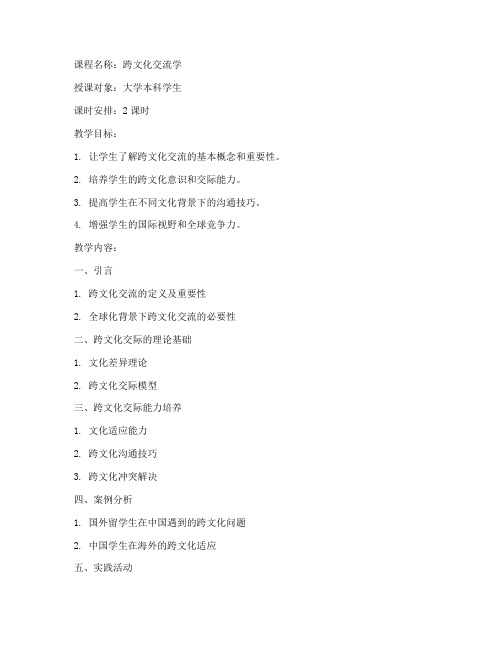
课程名称:跨文化交流学授课对象:大学本科学生课时安排:2课时教学目标:1. 让学生了解跨文化交流的基本概念和重要性。
2. 培养学生的跨文化意识和交际能力。
3. 提高学生在不同文化背景下的沟通技巧。
4. 增强学生的国际视野和全球竞争力。
教学内容:一、引言1. 跨文化交流的定义及重要性2. 全球化背景下跨文化交流的必要性二、跨文化交际的理论基础1. 文化差异理论2. 跨文化交际模型三、跨文化交际能力培养1. 文化适应能力2. 跨文化沟通技巧3. 跨文化冲突解决四、案例分析1. 国外留学生在中国遇到的跨文化问题2. 中国学生在海外的跨文化适应五、实践活动2. 跨文化交际情景模拟教学过程:第一课时:一、导入1. 提问:同学们,什么是跨文化交流?为什么跨文化交流如此重要?2. 引导学生思考:全球化背景下,跨文化交流对我们有什么影响?二、讲解跨文化交流的定义及重要性1. 跨文化交流的定义2. 跨文化交流的重要性三、介绍跨文化交际的理论基础1. 文化差异理论2. 跨文化交际模型四、案例分析1. 国外留学生在中国遇到的跨文化问题2. 中国学生在海外的跨文化适应第二课时:一、讲解跨文化交际能力培养1. 文化适应能力2. 跨文化沟通技巧3. 跨文化冲突解决二、实践活动1. 跨文化交际角色扮演三、总结1. 回顾本节课的主要内容2. 强调跨文化交流能力的重要性3. 布置课后作业:思考如何将所学知识应用于实际生活中教学评价:1. 学生对跨文化交流的定义和重要性有了更深入的理解。
2. 学生能够运用跨文化交际的理论基础分析实际问题。
3. 学生在实践活动中的表现,体现了跨文化交际能力的提升。
课后作业:1. 针对所学的跨文化交际技巧,思考如何将其应用于实际生活中。
2. 收集关于跨文化交流的案例,撰写一篇短文,分析案例中的跨文化问题及解决方法。
跨文化交际实用教程Unit7课件

倾听与尊重
积极倾听对方观点,尊重对方的
文化背景和价值观,避免偏见和
03
歧视。
适应与灵活变通
04 在交际过程中,灵活适应对方的 交际方式和文化背景,寻找共同 点与合作的可能性。
03
跨文化交际策略与技巧
文化适应策略
文化包容策略
在跨文化交际中,首先要采取文 化包容策略,尊重并接纳不同文 化背景的交际对象,以开放、宽
跨文化交际实用教程unit7课件
CONTENTS
• 引言 • 文化差异与交际障碍 • 跨文化交际策略与技巧 • 跨文化交际实践案例分析 • 跨文化交际自我提升计划
01
引言
跨文化交际定义与重要性
定义
跨文化交际是指不同文化背景的 人在交际过程中,通过语言、符 号等交流工具来传递信息、沟通 思想的过程。
调整
根据评估结果,对自我提升计划进行调整和优化。例如,如果发现某方面的能力 提升较慢,可以增加相关学习资源和实践机会;如果发现目标设定过高或过低, 可以适当调整目标。
谢谢您的聆听
THANKS
01
倾听技巧
在跨文化交际中,倾听是至关重要的技巧之一。交际者需要耐心倾听对
方表达,理解其观点和需求,从而做出恰准确传达,交际者需要掌握清晰、简洁、生动的表达技巧,
避免使用模糊、晦涩的措辞,降低误解的可能性。
03
非语言交际技巧
除了言语表达外,非语言交际如肢体语言、面部表情、声音语调等也在
旅游场合中的语言交流障碍
旅游时,语言交流障碍可能会给游客带来诸多不便,需要掌握基本的当地语言或英语等通用语言,并借助翻译工具等 解决交流问题。
跨文化交际在旅游服务中的重要性 旅游服务提供者需要掌握跨文化交际技巧,以提供更好的服务和体验,如酒店前台、导游等需要具备良 好的跨文化沟通和理解能力。
《跨文化沟通》教案

《跨文化沟通》教案教案:跨文化沟通一、教学目标:1.了解跨文化沟通的概念和重要性;2.掌握跨文化沟通中的常见障碍和解决方法;3.培养学生的跨文化意识和沟通能力。
二、教学内容:1.跨文化沟通的概念和重要性;2.跨文化沟通中的常见障碍;3.跨文化沟通中的解决方法;4.跨文化沟通的案例分析。
三、教学过程:1.预习导入:通过观看一段跨文化沟通失败的视频,引发学生对跨文化沟通的重要性和困难的思考。
2.理论讲解:a.跨文化沟通的概念和重要性:介绍跨文化沟通的定义和意义,让学生了解跨文化沟通与日常沟通的区别。
b.跨文化沟通中的常见障碍:介绍语言、文化差异、身体语言等在跨文化沟通中常见的障碍,通过讨论学生的经历和观察,让学生深入了解跨文化沟通的困难。
c.跨文化沟通中的解决方法:介绍学习对方语言和文化、尊重和理解对方、提前做好准备等解决方法,通过案例分析和讨论让学生掌握这些解决方法的应用。
3.案例分析:a.教师给出几个跨文化沟通的案例,并组织学生进行分析和讨论,让学生体会到跨文化沟通中的难题和解决方法的实用性。
b.学生分组讨论自己在跨文化沟通中遇到的难题和解决方法,并向全班汇报,进行互动和交流。
4.总结和评价:a.教师对本次课程进行总结,强调跨文化沟通的重要性,并展望下一次课程的内容。
b.学生对本堂课进行评价和反馈,提出自己的问题和建议。
四、教学方法:1.案例分析法:通过真实的案例让学生理解和分析跨文化沟通中的问题和解决方法,增强学生的实际操作能力。
2.合作学习法:通过分组讨论和互动,培养学生的合作和团队精神,增强学生之间的互动和交流。
3.观察法:教师通过观察学生的表现和讨论,了解学生对跨文化沟通的理解和掌握程度,并及时进行调整和指导。
五、教学评价:1.学生的参与度和表现情况:观察学生在案例分析和讨论中的表现和参与度,看是否能够积极提出观点和解决方法。
2.学生的讨论和汇报情况:评价学生在分组讨论和汇报中的表现,看是否能够清晰地表达观点并与他人进行有效的交流。
引导大学生跨文化交流的教案

引导大学生跨文化交流的教案一、引言本文档旨在提供一份教案,帮助大学生更好地进行跨文化交流。
随着全球化的进程,跨文化交流能力已成为现代社会越来越重要的技能之一。
通过本教案的实施,希望培养学生们在不同文化背景下进行有效沟通和合作的能力。
二、目标1.帮助学生了解和尊重不同文化差异。
2.提高学生的跨文化沟通和适应能力。
3.培养学生具有开放心态,愿意接触并理解其他文化。
4.培养跨文化合作与协商技巧。
三、教案内容步骤一:培养跨文化意识•介绍不同国家和地区的文化特点,包括语言、宗教、风俗习惯等方面。
•组织讨论,让学生们分享自己对其他文化的认知和偏见,并加以解决。
步骤二:提高跨文化沟通技巧•探讨非语言沟通方式在不同文化中的差异和重要性。
•分析常见的跨文化沟通挑战,并提供解决方案,如尊重他人观点、倾听和掌握基本礼仪等。
步骤三:培养开放心态与包容力•鼓励学生们主动参与不同文化活动,如语言交换会、国际社团等。
•引导学生反思自己的文化观念和偏见,并学习欣赏其他文化之美。
步骤四:训练跨文化合作与协商技巧•组织模拟跨文化合作场景,让学生们感受到在团队合作中不同文化间的碰撞和融合。
•提供教材或案例研究,帮助学生们理解并应对跨文化冲突。
四、教学方法1.创设多元环境:组建国际交流小组,邀请外籍教师或志愿者来校交流经验。
2.活动实践:组织实地考察、游戏互动等形式,加深学生对不同文化的体验。
3.视频资源利用:引入相关视频、纪录片等素材,观看和讨论。
五、教学评估1.检查学生对不同文化差异的了解程度。
2.评估学生在跨文化沟通情境中的表现,包括语言运用、姿态等。
3.分析学生参与跨文化合作活动的积极性和成果。
六、结语本教案旨在引导大学生们更好地进行跨文化交流,并提高他们的跨文化意识和沟通技巧。
通过多元的教学方法和实践活动,希望能够帮助学生们逐步培养开放的心态和包容力,为未来在全球化社会中取得成功打下坚实基础。
大学跨文化交流课程教案
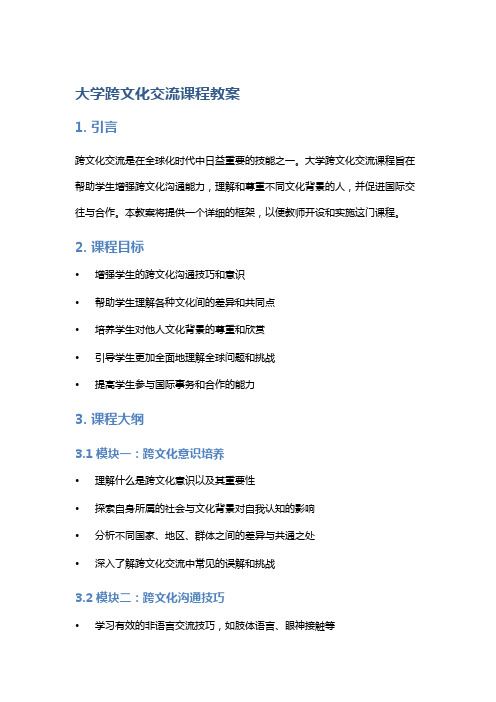
大学跨文化交流课程教案1. 引言跨文化交流是在全球化时代中日益重要的技能之一。
大学跨文化交流课程旨在帮助学生增强跨文化沟通能力,理解和尊重不同文化背景的人,并促进国际交往与合作。
本教案将提供一个详细的框架,以便教师开设和实施这门课程。
2. 课程目标•增强学生的跨文化沟通技巧和意识•帮助学生理解各种文化间的差异和共同点•培养学生对他人文化背景的尊重和欣赏•引导学生更加全面地理解全球问题和挑战•提高学生参与国际事务和合作的能力3. 课程大纲3.1 模块一:跨文化意识培养•理解什么是跨文化意识以及其重要性•探索自身所属的社会与文化背景对自我认知的影响•分析不同国家、地区、群体之间的差异与共通之处•深入了解跨文化交流中常见的误解和挑战3.2 模块二:跨文化沟通技巧•学习有效的非语言交流技巧,如肢体语言、眼神接触等•掌握合适的礼仪与行为准则•学习如何正确使用隐喻、谚语和比喻等文化特定的表达方式•培养灵活性和适应能力以应对不同文化背景下的沟通难题3.3 模块三:文化差异与共同点分析•研究不同文化背景下的价值观、信仰体系和社会习俗•分析不同文化对时间、个人空间、权力结构等方面的理解和处理方式的差异•探索全球主要文化社群之间的相似之处,从而建立联系和互信3.4 模块四:跨文化问题和挑战•研讨全球性问题,如多元社会中的种族歧视、性别平等、环境保护等议题•分析当今世界面临的移民、国际贸易和政治争端等跨文化挑战•引导学生探索如何通过跨文化合作和理解来解决这些问题3.5 模块五:实践项目•学生分组完成一个真实的跨文化项目,例如组织国际文化节或参与志愿者服务等•提供指导和支持,鼓励学生应用他们在课堂上学到的知识和技能•写出项目总结报告,并让学生分享他们在项目中的经验和收获4. 教学方法与评估方式•教学方法:讲座、小组讨论、角色扮演、案例分析等•评估方式:课堂参与度、小组任务成果评估、个人反思日志、最终项目报告等多样化形式相结合5. 教材推荐•"Intercultural Communication: A Global Reader" by Larry Samovar and Richard E. Porter•"Cross-Cultural Connections: Stepping Out and Fitting In Around the World" by Duane Elmer•"Communicating Across Cultures" by Stella Ting-Toomey6. 结语大学跨文化交流课程的教案为教师提供了一个有力的工具,帮助学生掌握重要的跨文化沟通技能和思维方式。
《跨文化交流》教案

《跨文化交流》教案跨文化交流教案1. 教案简介本教案旨在帮助学生了解和研究跨文化交流的重要性和技巧。
通过教授相关的理论知识和实践活动,学生将能提高自己的跨文化交流能力,更好地适应多元文化环境。
2. 教学目标- 了解跨文化交流的定义和重要性;- 掌握基本的跨文化交际技巧;- 培养学生的开放心态和敏感性,增强与不同文化的人交流的能力。
3. 教学内容和流程第一课:跨文化交流的概念- 介绍跨文化交流的定义和背景;- 分享一些跨文化交流的案例,引发学生的兴趣;- 引导学生思考跨文化交流所面临的挑战和机遇。
第二课:跨文化交际技巧- 提供一些基本的跨文化交际技巧,如尊重差异、倾听和观察等;- 分组讨论和角色扮演活动,让学生实践这些技巧;- 引导学生思考如何解决跨文化交流中的冲突和误解。
第三课:培养开放心态和敏感性- 讨论多元文化的概念和重要性;- 分享一些案例,让学生理解不同文化之间的共同点和差异;- 引导学生尊重并接纳不同文化的观念和行为方式。
第四课:跨文化交流实践- 设计实践活动,如访谈外国留学生或观察不同文化的社交活动;- 学生根据实践经验反思和总结,分享他们的体验和感受;- 教师提供反馈和建议,帮助学生改进跨文化交流能力。
4. 评估方法- 学生小组讨论和角色扮演的表现;- 学生的实践活动报告和反思;- 学生之间的互动和交流。
5. 教学资源- 教材:跨文化交流教育指南;- 多媒体设备:投影仪、音频设备等;- 实践活动所需材料。
6. 参考文献以上是《跨文化交流》教案的内容和流程,希望能帮助学生提高跨文化交流能力,增进他们的跨文化理解和包容性。
关于跨文化交流的教案
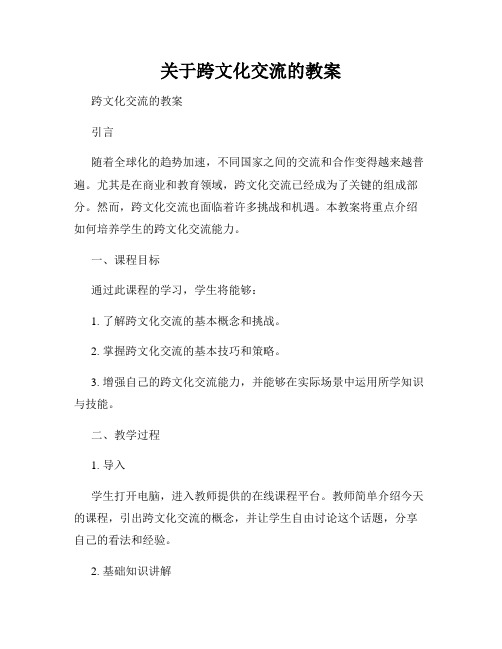
关于跨文化交流的教案跨文化交流的教案引言随着全球化的趋势加速,不同国家之间的交流和合作变得越来越普遍。
尤其是在商业和教育领域,跨文化交流已经成为了关键的组成部分。
然而,跨文化交流也面临着许多挑战和机遇。
本教案将重点介绍如何培养学生的跨文化交流能力。
一、课程目标通过此课程的学习,学生将能够:1. 了解跨文化交流的基本概念和挑战。
2. 掌握跨文化交流的基本技巧和策略。
3. 增强自己的跨文化交流能力,并能够在实际场景中运用所学知识与技能。
二、教学过程1. 导入学生打开电脑,进入教师提供的在线课程平台。
教师简单介绍今天的课程,引出跨文化交流的概念,并让学生自由讨论这个话题,分享自己的看法和经验。
2. 基础知识讲解教师通过PPT演示介绍跨文化交流的基本概念、挑战和必备技能。
如:(1)文化差异的概念和影响;(2)语言交流中的误解和解决方法;(3)身体语言与文化差异;(4)尊重他人和差异的原则;(5)适应当地的言行举止。
教师要注意与学生互动,引导学生思考和参与讨论。
3. 实操演练教师利用多媒体工具,设计并呈现一些跨文化交流场景,如接待外宾、跟本地人交流等等。
学生可以自由地发挥自己的想象,模拟出实际的情境,并进行交流。
每个学生都应该有机会参与,教师可以根据需求分组或者个别提供指导。
4. 总结反馈课程结束前,教师对今天的教学过程和学生的表现进行总结和反馈。
同时,也鼓励学生留下自己的思考和感受,促进学生自主学习和思考。
三、教学评估评估方式:学生自评、互评、教师评估评估标准:1. 学习过程中是否认真参与。
2. 跨文化交流能力的提升。
3. 能否在实际情境下灵活运用所学知识和技能。
四、参考资料1. Zhou, X. (2017). Intercultural communication for global business: How leaders communicate for success. Springer.2. Jandt, F. E. (2019). An introduction to intercultural communication: Identities in a global community. Sage Publications.3. Gudykunst, W. B., & Kim, Y. Y. (Eds.). (2020). Theories in intercultural communication. Sage Publications.。
跨文化课程设计

跨文化课程设计一、教学目标本课程旨在帮助学生掌握跨文化沟通的基本知识和技能,提高他们在多元文化环境下的交流与合作能力。
具体目标如下:1.了解世界各国文化的基本特点和差异。
2.掌握跨文化沟通的基本理论和方法。
3.熟悉国际礼仪和跨文化商务沟通策略。
4.能够运用跨文化沟通技巧进行有效交流。
5.具备分析跨文化情境下的沟通问题的能力。
6.学会制定和实施跨文化团队合作策略。
情感态度价值观目标:1.培养对不同文化的尊重和理解。
2.增强团队协作精神和跨文化同理心。
3.树立正确的跨文化沟通观念,提高跨文化竞争力。
二、教学内容本课程的教学内容主要包括以下几个部分:1.跨文化沟通的基本概念:文化差异、文化冲击、跨文化交际等。
2.跨文化沟通的理论:霍夫斯泰德文化维度理论、跨文化沟通模型等。
3.跨文化沟通技巧:非语言沟通、跨文化商务沟通、冲突管理等。
4.跨文化情境下的沟通实践:国际商务谈判、跨文化团队协作等。
5.跨文化礼仪和习俗:世界各国礼仪、商务礼仪、跨文化敏感性问题等。
三、教学方法为了提高教学效果,本课程将采用多种教学方法相结合的方式,包括:1.讲授法:讲解跨文化沟通的基本理论和知识。
2.案例分析法:分析典型跨文化沟通案例,提高学生的问题解决能力。
3.小组讨论法:分组讨论,培养学生的团队协作和沟通能力。
4.角色扮演法:模拟跨文化沟通情境,提高学生的实际操作能力。
5.实验法:通过实验室模拟,让学生在实践中掌握跨文化沟通技巧。
四、教学资源为了支持本课程的教学,我们将准备以下教学资源:1.教材:《跨文化沟通与管理》、《国际礼仪与跨文化商务沟通》等。
2.参考书:提供相关领域的书籍,供学生拓展阅读。
3.多媒体资料:制作课件、教学视频等,丰富教学手段。
4.实验设备:实验室设施,用于模拟跨文化沟通情境。
5.在线资源:利用网络资源,为学生提供更多的学习材料和案例。
五、教学评估本课程的评估方式包括平时表现、作业、考试等多个方面,以全面客观地评价学生的学习成果。
大学生跨文化交流教育教案

大学生跨文化交流教育教案引言在当今全球化的时代,跨文化交流教育变得愈发重要。
大学生作为未来社会的重要一员,需要具备跨文化交流的能力。
然而,由于文化差异和语言障碍的存在,大学生在跨文化交流中常常遇到困难。
因此,为大学生设计一套有效的跨文化交流教育教案,以培养他们的跨文化交流能力,具有重要的意义。
跨文化交流的重要性跨文化交流是不同文化之间的相互作用和交流的过程。
在全球化的今天,文化多样性已成为社会的重要特征之一,跨文化交流的能力对于个人和社会的发展都有着重要的影响。
首先,跨文化交流能够帮助个体更好地理解和尊重不同文化。
不同的文化有着不同的价值观、习俗和信仰,通过跨文化交流,人们可以更深入地了解其他文化,从而避免错误的理解和偏见。
其次,跨文化交流能够促进文化创新和发展。
通过与其他文化的交流,不同文化之间的相互影响和借鉴可以产生新的思想和观念,进而推动文化的创新和发展。
最后,跨文化交流能够促进国际合作和友谊。
在跨文化交流的过程中,人们能够建立起跨越国界的友谊关系,促进国际间的合作与发展。
基于以上原因,跨文化交流教育变得越来越重要,尤其是对于大学生来说,他们将成为未来社会的重要一员,需要具备跨文化交流的能力。
跨文化交流教育的挑战尽管跨文化交流教育的重要性被广泛认可,但实施起来面临着许多挑战。
以下是一些主要的挑战:1. 文化差异不同文化之间存在着差异,包括价值观、习俗、沟通方式等方面的差异。
这些差异经常导致误解和不适应,使跨文化交流变得困难。
2. 语言障碍语言是文化交流的桥梁,但不同文化间的语言差异会成为跨文化交流的障碍。
即便使用共同的语言,不同的语言习惯和表达方式也会导致误解和交流困难。
3. 具体实践跨文化交流不仅仅是理论上的知识,更需要在实践中去体验和学习。
但是,由于成本和时间等原因,学生参与跨文化交流的机会有限,缺乏实际操作的经验。
设计一套大学生跨文化交流教育教案为了帮助大学生克服跨文化交流教育的挑战,下面设计了一套大学生跨文化交流教育教案:第一阶段:了解文化差异H2:文化概述•在第一阶段,教案将向学生介绍不同文化之间的基本概念和特征,让学生对跨文化交流有一个初步的了解。
清华大学跨文化课程教案7

Chapter 7 Cultural Patterns
4. Masculinity and femininity
In masculine cultures both man and women are relatively tough, and social gender roles are clearly distinct. Men are supposed to be assertive, tough, and focused on material success, whereas women are supposed to be more modest, tender and concerned with the quality of life.
清华大学跨文化课程教案7
Chapter 7 Cultural Patterns
Text C: Edward T. Hall’s Contextculture theory
1)The definition of context: “the information that surrounds an event; it
Chapter 7 Cultural Patterns
Exploring Ideas
跨文化交流教案课程

跨文化交流教案课程介绍跨文化交流教案课程旨在帮助学生提高跨文化沟通能力,培养跨文化意识和解决跨文化冲突的技巧。
本教案包含丰富多样的教学活动和资源,让学生在研究中获得实际经验并提升自己的交流能力。
教学目标- 帮助学生理解跨文化交流的重要性和挑战- 提高学生的跨文化沟通和解决冲突的能力- 培养学生的跨文化意识和敏感性- 培养学生的自我反思和适应能力教学内容1. 跨文化意识培养- 探索不同文化的特点和价值观- 分析跨文化冲突的原因和解决方法- 研究如何尊重和欣赏不同文化2. 跨文化沟通技巧- 研究有效的跨文化沟通策略和技巧- 研究如何解读非语言交流和跨文化障碍- 实践跨文化交流技巧的活动3. 跨文化冲突解决- 研究分析和解决跨文化冲突的方法- 培养学生的冲突解决能力和谈判技巧- 进行跨文化冲突案例研究4. 跨文化实践体验- 组织学生参加跨文化实践活动,如文化交流活动、社区服务等- 学生分享和讨论实践体验,提高反思和适应能力教学方法- 小组讨论和合作研究- 视听材料的使用和讨论- 角色扮演和模拟跨文化情景- 实地参观和体验跨文化环境- 学生个人报告和讨论评估方式- 参与度和课堂表现- 小组讨论和合作活动成果- 书面作业和个人报告- 跨文化实践活动反馈评估参考资源- 文化交流案例研究资料- 跨文化交流视频和文字材料- 跨文化交流工具和测试问卷- 跨文化沟通技巧指南和手册教学进度安排- 第一周:导入和介绍跨文化交流教学目标- 第二周:跨文化意识培养活动- 第三周:跨文化沟通技巧研究- 第四周:跨文化冲突解决案例研究- 第五周:跨文化实践体验和反馈讨论- 第六周:总结和教学评估以上是《跨文化交流教案课程》的基本内容和教学安排。
该课程将帮助学生提升跨文化交流能力,增加跨文化意识和解决冲突的技巧。
希望学生能够通过该课程获得实际经验,并在未来的跨文化交流中更加自信和成功。
跨文化交流教案

跨文化交流教案目录1. 引言2. 教学目标3. 教学内容4. 教学方法5. 教学过程6. 教学评估7. 教学反思8. 结论9. 参考文献1. 引言跨文化交流在当今社会变得越发重要。
由于全球化的发展,人们与来自不同国家和文化背景的人交往机会越来越多。
因此,培养学生的跨文化交际能力成为现代教育的任务之一。
本教案将重点介绍如何设计一堂有效的跨文化交流教学课程,以帮助学生更好地理解和应对跨文化交际的挑战。
2. 教学目标- 了解不同文化背景对交流的影响- 掌握跨文化交际的基本原则和技巧- 培养尊重、理解和包容不同文化的意识- 提高跨文化交际能力,包括口头和书面交流能力3. 教学内容- 文化概念和定义- 文化差异的原因和影响- 跨文化交际中的常见问题和挑战- 跨文化交际的基本原则和技巧- 跨文化交流中的非语言交际- 跨文化交际的实践技巧和策略4. 教学方法- 授课讲解:通过讲解文化概念和跨文化交流的基本原则,帮助学生建立跨文化交流的基本理论框架。
- 小组讨论:将学生分成小组,让他们讨论并分享自己的跨文化交流经历,并从中总结出交际中遇到的问题和应对策略。
- 角色扮演:设计一些跨文化情景,让学生进行角色扮演,锻炼他们的跨文化交流能力。
- 多媒体展示:使用图片、视频等多媒体资源展示和比较各种文化背景下的交流方式和观念,帮助学生更直观地理解文化差异。
5. 教学过程- 第一步:引入跨文化交流的概念,让学生了解跨文化交流的重要性和挑战。
- 第二步:讲解文化的定义和影响,并引导学生思考文化差异的原因。
- 第三步:介绍跨文化交际的基本原则和技巧,如尊重、理解和包容不同文化等。
- 第四步:通过小组讨论和角色扮演,让学生运用所学原则和技巧,解决跨文化交流中的问题。
- 第五步:展示多媒体资源,比较不同文化背景下的交流方式和观念,引发学生思考。
- 第六步:总结课堂内容,强调培养跨文化交流能力的重要性,并提供相关练习和学习资源。
6. 教学评估- 合作讨论和角色扮演的表现评估- 学生提交的笔记和小组讨论总结- 学生参与度和互动情况的观察评估- 学习成果的书面测试或口头报告7. 教学反思在教学过程中,可以根据学生反馈和实际情况进行灵活调整。
跨文化交流教育教学教案

跨文化交流教育教学教案背景介绍跨文化交流教育是现代教育领域中一项重要的教学内容。
在全球化的背景下,各国之间的交流与合作日益频繁,培养学生跨文化交流能力变得越来越重要。
本教案旨在帮助学生掌握跨文化交流的基本原则和技巧,提高他们的跨文化交流能力。
教学目标- 了解跨文化交流的重要性和必要性- 理解不同文化背景下的沟通障碍- 研究基本的跨文化交流技巧- 提高自己的跨文化交流能力教学内容1. 跨文化交流的定义和意义- 介绍跨文化交流的概念和定义- 强调跨文化交流在现代社会中的重要性和必要性2. 跨文化沟通的挑战和障碍- 分析不同文化背景下的价值观、、行为惯等差异- 探讨这些差异对跨文化交流的影响和挑战3. 跨文化交流的基本原则和技巧- 强调尊重和包容不同文化的重要性- 研究如何倾听和理解跨文化对话中的不同观点和意见- 讨论如何适应和调整自己的沟通方式以促进跨文化交流4. 案例分析和实践活动- 分析真实的跨文化交流案例,探讨其中的问题和解决方案- 进行跨文化交流实践活动,让学生亲身体验并提升自己的跨文化交流能力教学方法- 讲授:通过讲授基本原理和技巧,帮助学生理解和掌握跨文化交流的要点- 讨论:通过小组讨论或全班讨论,促进学生思考和交流- 案例分析:通过分析真实案例,让学生学会分析问题和提出解决方案- 实践活动:通过实际跨文化交流活动,让学生在实践中提升自己的能力教学评估- 小组讨论的参与度和质量- 案例分析报告的分析能力和解决方案- 实践活动中的表现和反馈参考资源- 跨文化交流研究资料和案例- 跨文化交流相关的书籍和论文以上是《跨文化交流教育教学教案》的大致内容和教学方法。
通过教授这份教案,我们可以帮助学生提高跨文化交流能力,使他们在未来的国际交往中更加自信和成功。
《跨文化沟通》参考教案

《跨文化沟通》课程教案(供教师参考)全书共3部分,12课:跨文化基本概念、跨文化技能、跨文化应用教学目的:培养学生全球视野、跨文化思维、跨文化适应与沟通能力:教学理念与方法:1、项目导向、案例分析+任务驱动三合一教学法 (案例分析、直面现实、展望未来)案例分析(What's wrong, Intercultural case study)引导学生分析案例:先问该案例文化冲突点,然后对此展开跨文化分析,最后提出解决方案以及如何避免类似的跨文化冲突。
案例分析之后,教师引导学生思考现实社会中的种种跨文化问题,直面现实社会中的跨文化问题,培养学生发现问题、分析问题、解决实际问题的能力。
这些现实社会中的跨文化问题,需要教师积极引导,让学生思考,最后可以由教师提出,组织学生参与讨论。
目的:培养学生积极参与讨论意识、鼓励学生主动表达、发表各自观点。
教师不做否定学生观点评论,但鼓励学生阐述为何这样分析,注意,教师应该多鼓励学生,即使其观点不十分到位,因为分析案例不是仅仅为了达到解决案例的目的,而是通过案例分析的过程,培养学生参与讨论、发表观点甚至不同观点的意识与积极性。
课文(阅读一为主)课文后的问题都是开放式的问题,可以鼓励学生自由发挥,畅所欲言。
教师可聚焦课文中的跨文化要点而非语言点。
教师可先问学生本课文的跨文化要点,之后教师可做些解释、分析与补充。
跨文化视角这是跨文化沟通教程的重点,也是培养学生跨文化思维的路径,教师可以做些讲解与说明,强调这些是学生今后用于跨文化问题分析的视角。
跨文化项目(问题导向)让学生以团队形式完成每一单元之后的跨文化项目,培养学生学以致用的能力,同时也培养学生团队合作能力,培养学生未来职场竞争力。
这一教学过程体现教学理念:培养学生直面现实问题,分析与解决现实问题的能力,这也是评估学生学习效果。
考试建议考试的目的是检查学生学习本课程之后是否已理解与掌握了有关知识与能力,建议考试以写课程论文为主,并用中文写,可以让学生自由选择课程论文的题目,3人一组团队完成论文。
- 1、下载文档前请自行甄别文档内容的完整性,平台不提供额外的编辑、内容补充、找答案等附加服务。
- 2、"仅部分预览"的文档,不可在线预览部分如存在完整性等问题,可反馈申请退款(可完整预览的文档不适用该条件!)。
- 3、如文档侵犯您的权益,请联系客服反馈,我们会尽快为您处理(人工客服工作时间:9:00-18:30)。
Chapter 7 Cultural Patterns
5. Relational orientation
?a. Value - Individualism Orientation ?b. Value - Lineality Orientation ?c. Value - Collaterality Orientation
? Blood is thicker than water. ? Time is money. ? A man's house is his castle. ? The early bird catches the worm. ? 人之初,性本善。 ? 天人感应。 ? 一人得道,鸡犬升天。 ? 以人为鉴,可以明得失;以史为鉴,
Definition
Components
Edward T Hall's Context - Culture Theory
Kluckhohn Strodtbeck's Orientation
and Value
Hofstede's Dimensions of Cultural Variability
Ways
4. Activity orientation
Chapter 7 Cultural Patterns
?a. Value - Doing Orientation ?b. Value - Being Orientation ?c. Value - Being-in-Becoming Orientation
Chapter 7 Cultural Patterns
Text C: Edward T. Hall's Context culture theory
1)The definition of context: “the information that surrounds an event; it
is inextricably bound up with the mean-ing of the event.” 2)Categorization of high-context culture and low-context culture depending on the degree to which meaning comes from the set-tings or from the words being exchanged.
大学英语 跨文化交际
Chapter 7 Cultural Patterns
黑龙江大学外语部
Learning objectives:
Chapter 7 Cultural Patterns
Chapter 7 Cultural Patterns
Chapter Outline
Cultural Patterns
Chapter 7 Cultural Patterns
Social Practices
Social practices are the predictable behavior patterns that members of a culture typically follow. Thus, social practices are the outward manifestations of beliefs, values, and norms.
of
Thinking
Ways
of
Acting
Beliefs Values Norms
Social Practices
High-context Low-context
Human Nature Person-Nature
Time Activity Relational
Individualism
and
Collectivism
Chapter 7 Cultural Patterns
1. Individualism versus collectivism
The characteristics of cultures that value individualism
? People's personal goals take priority over their groups like the family or the employer.
Chapter 7 Cultural Patterns
Exploring Ideas
?What would you add or change to more accurately express the Chinese orientation to relation? Is the relational orientation changing? What is your evidence?
while very little is in
the coded, explicitly
transmit-ted part of
the message.
Tea Ceremony
Chapter 7 Cultural Patterns
Low-context culture
?A low context (LC) communication is just the opposite; i.e., the mass of the information is vested in the explicit code.”
Uncertainty Avoidance
Power distance
Masculinity
–
Femininity
Chapter 7 Cultural Patterns
Lead-in Case: Marriage and Social status
Chapter 7 Cultural Patterns
?
Lower-Context Cultures
Chapter 7 Cultural Patterns
Case Analysis - “wrong signals”
Chapter 7 Cultural Patterns
What's the values reflected in the following proverbs?
evil but perfectible
good but corruptible
Chapter 7 Cultural Patterns
2. Person-nature orientation
(1) mastery with nature(注:图片为愚公移山) (2) harmony with nature (注:图片为中药材) (3) subjugation to nature (注:图片为印尼海啸)
?
High-Context Cultures
?
Japanese
?
Chinese
?
Korean
?
African American
?
Native American
?
Arab
?
Greek
?
Latin
?
Italian
?
English
?
French
?
American
?
Scandinavian
?
German
?
German-Swiss
Chapter 7 Cultural Patterns
High-context culture
? “Ahigh context (HC)
communication or
message is one in
which most of the
infor- mation
is
alreadr 7Cultural Patterns
Text E: Hofstede's cultural dimensions
1. Individualism versus collectivism 2. Uncertainty avoidance 3. Power distance 4. Masculinity versus femininity
可以知兴替。
Chapter 7 Cultural Patterns
Text D: Kluckhohn and Strodtbeck's value orientation
1. Human nature orientation 2. Person-nature orientation 3. Time orientation 4. Activity orientation
An American standing on chair in restaurant
giving speech at his leaving his hometown
Chapter 7 Cultural Patterns
Cultures Arranged Along the High-
Context and Low-Context Dimension
mastery with nature
subjugation to nature
harmony with
nature
mastery with nature
3. Time orientation
Chapter 7 Cultural Patterns
a. Value - Past Orientation b. Value - Present Orientation c. Value - Future Orientation
? The loyalty of individualists to a given group is very weak. ? People feel they belong to many groups and are apt to change their
